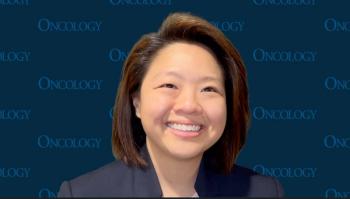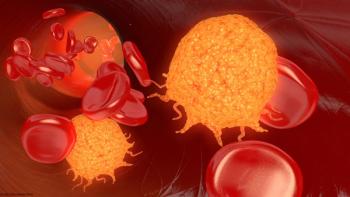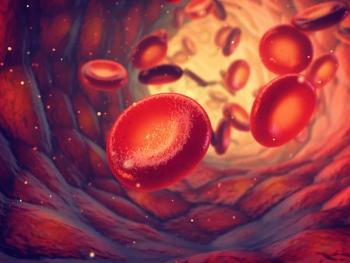
Significant OS Benefit Observed With NAT Nivolumab/Chemo in Resectable NSCLC
Results from CheckMate-816 could be practice-changing after an OS improvement was noted with NAT nivolumab plus chemotherapy in resectable NSCLC.
A statistically significant and clinically meaningful overall survival (OS) benefit was observed when neoadjuvant novolumab (Opdivo) plus chemotherapy vs chemotherapy alone was used to treat patients with resectable non–small cell lung cancer (NSCLC), according to findings from the phase 3 CheckMate-816 study (NCT02998528) presented during the
At a median follow-up of 68.4 months, the median OS was not reached (NR) with nivolumab plus chemotherapy (n = 179) vs 73.7 months with chemotherapy alone (n = 179), translating to a 28% reduction in the risk of death (HR, 0.72; 95% CI, 0.523-0.998; P = .0479). The 60-month OS rate in the nivolumab arm was 65% vs 55% in the chemotherapy-alone arm.
When broken down by stage of disease at baseline, those with stage IB to II disease who received nivolumab plus chemotherapy (n = 65) experienced a median OS that was NR vs 76.8 months with chemotherapy alone (n = 61; HR, 0.77; 95% CI, 0.44-1.35). The 60-month OS rates in the respective arms were 65% and 60%. In those with stage IIIA disease who received nivolumab (n = 113) had a median OS that was NR vs 73.7 months in those who received chemotherapy alone (n = 116; HR, 0.70; 95% CI, 0.47-1.05). The 60-month OS rates in the respective arms were 65% and 53%.
When broken by tumor PD-L1 expression, those with PD-L1 under 1% who received nivolumab plus chemotherapy (n = 78) experienced a median OS that was NR vs 61.8 months with chemotherapy alone (n = 77; HR, 0.89; 95% CI, 0.57-1.41). The 60-month OS rate was 53% in both arms. Those with a PD-L1 of 1% or higher who received nivolumab/chemotherapy (n = 89) had a median OS that was NR vs 73.7 months with chemotherapy alone (n = 89; HR, 0.51; 95% CI, 0.31-0.84). The 60-month OS rate with nivolumab was 78% vs 58% with chemotherapy alone.
“CheckMate-816 is the only phase 3 trial of neoadjuvant-only chemoimmunotherapy to demonstrate a statistically significant OS benefit across any resectable solid tumor type and affirm a paradigm shift in the treatment of resectable NSCLC without actionable genomic alterations,” Patrick M. Forde, MBBCh, of Trinity St. James’s Cancer Institute, Trinity College Dublin, in Dublin, Ireland, said in an oral presentation of the data.
Checking Out CheckMate-816: Design
The trial enrolled patients with newly diagnosed, resectable, stage IB to IIIA NSCLC who had an ECOG performance status of 0 or 1 without known sensitizing EGFR mutations or ALK alterations. Participants (n = 358) were randomly assigned 1:1 to receive 360 mg of nivolumab every 3 weeks plus chemotherapy every 3 weeks for 3 cycles vs chemotherapy every 3 weeks for 3 cycles. Those with nonsquamous disease in the nivolumab arm received pemetrexed plus cisplatin or paclitaxel plus carboplatin; those with squamous disease received gemcitabine plus cisplatin or paclitaxel plus carboplatin.In the control arm, chemotherapy could have been vinorelbine plus cisplatin, docetaxel plus cisplatin, gemcitabine plus cisplatin (squamous only), pemetrexed plus cisplatin (nonsquamous only), or paclitaxel plus carboplatin.
After treatment, patients underwent radiologic restaging; 6 weeks after treatment, patients underwent surgery and then went on to receive optional adjuvant chemotherapy and/or radiation before entering follow-up.
The primary end points of the study were pathologic complete response (pCR) and event-free survival (EFS), both by blinded review. Key secondary end points included OS, major pathologic response, and time to distant metastases. Exploratory analyses examine OS by pCR and circulating tumor DNA clearance, as well as lung cancer–specific survival (LCSS).
For the primary analysis, pCR and EFS for nivolumab plus chemotherapy vs chemotherapy were respectively tested with 1% and 4% type I error. If the pCR was determined to be of statistical significance, EFS was evaluated with a 2-sided type I error of 5%. If pCR and EFS were determined to both be significant, OS was to be assessed hierarchically with a 2-sided type I error of 5%.
The OS final analysis was slated to occur at 185 events or 5 years of minimum follow-up, whichever was first. “The significance boundary was calculated to be a 2-sided P value of 0.482 at the final database lock,” Forde said. The OS data were presented at the meeting.
Additional Insights from the Latest Analysis
In concurrently randomized patients who received nivolumab/chemotherapy (n = 179), 31% of patients received subsequent therapy; 16% received radiotherapy, 3% underwent surgery, and 25% received systemic therapy, which included chemotherapy (23%), immunotherapy (11%), VEGF inhibition (7%), EGFR or ALK TKIs (3%), or other (1%). In the chemotherapy arm (n = 179), 51% of patients received subsequent therapy; 25% received radiotherapy, 5% underwent surgery, and 43% received systemic treatment.
In those with disease progression or recurrence who received nivolumab/chemotherapy (n = 67), 75% received subsequent therapy; 37% received radiotherapy and 9% underwent surgery. In the chemotherapy-alone arm (n = 94), 90% received subsequent therapy; 44% had radiotherapy and 8% underwent surgery. In the respective arms, 58% and 78% of patients received systemic therapy; 25% and 51% of patients, respectively, received immunotherapy.
The median LCSS was NR with nivolumab/chemotherapy and NR with chemotherapy alone (HR, 0.65; 95% CI, 0.44-0.96); the 60-month LCSS rates in the respective arms were 75% and 65%. The median EFS was 59.6 months with nivolumab plus chemotherapy vs 21.1 months with chemotherapy alone (HR, 0.68; 95% CI, 0.51-0.91). The 60-month EFS rates in the respective arms were 49% and 34%.
Revelations from Exploratory Analyses
Data from the exploratory analysis showed that in concurrently randomized patients, 24% of those in the nivolumab/chemotherapy and 2% of those in the chemotherapy-alone arm experienced a pCR. In those who had a pCR or did not have a pCR in the nivolumab arm, the median OS was NR for both (HR, 0.11; 95% CI, 0.04-0.36). In the chemotherapy arm, those who had a pCR or did not have a pCR had a median OS that was NR or 73.7 months, respectively.
“In the nivolumab plus chemotherapy arm, among patients with a pCR, death occurred in 3 patients, but none were due to disease,” Forde said. “Among patients with no pCR, there were a total of 62 deaths; 44 were due to disease.”
Those who had a pCR in the nivolumab/chemotherapy arm had a median EFS that was NR; those who did not have a pCR had a median EFS of 27.8 months (HR, 0.14; 95% CI, 0.06-0.33). In the chemotherapy-alone arm, those with a pCR had a median EFS that was NR and those who did not have a pCR had a median EFS that was 20.8 months.
“In the nivolumab plus chemotherapy arm, among patients with a pCR, 3 had disease recurrence or relapse,” Forde said. “Among patients with no pCR, 57 patients had disease recurrence or relapse.”
Investigators also looked at OS by ctDNA clearance and showed that among patients with detectable levels at cycle 1, 56% of those in the nivolumab arm and 35% of those in the chemotherapy-alone arm experienced clearance. In the nivolumab arm, those with ctDNA clearance had a median OS that was NR; those without clearance had a median OS of 61.5 months (HR, 0.38; 95% CI, 0.15-1.00). In the chemotherapy-alone arm, those with clearance had a median OS that was NR and those without clearance had a median OS of 69.2 months (HR, 0.39; 95% CI, 0.14-1.11).
Safety Spotlight
The safety profile of neoadjuvant nivolumab plus chemotherapy was in line with what has previously been reported. In the nivolumab/chemotherapy arm (n =176), adverse effects (AEs) were reported in 94% of patients; they were grade 3 or 4 for 43% of patients. Treatment-related AEs were experienced by 84% of patients and they were grade 3 or 4 for 36% of patients. Serious AEs (SAEs) occurred in 17% of patients and they were grade 3 or 4 for 11% of patients. Treatment-related SAEs occurred in 12% of patients and 8% of these cases were grade 3 or 4 in severity. Surgery-related AEs occurred in 45% of patients; they were grade 3 or 4 for 11% of patients. Any-grade TRAEs led to discontinuation for 10% of patients.
“Grade 5 surgery-related AEs occurred in 2 patients in the nivolumab plus chemotherapy arm, 1 each due to pulmonary embolism and aortic rupture; both were unrelated to study drug,” Forde concluded.
Reference
Forde PM, Spicer JD, Provencio M, et al. Overall survival with neoadjuvant nivolumab + chemotherapy in patients with resectable NSCLC in CheckMate 816. J Clin Oncol. 2025;43(suppl 17):LBA8000. doi:10.1200/JCO.2025.43.17_suppl.LBA8000
Newsletter
Stay up to date on recent advances in the multidisciplinary approach to cancer.


















































































